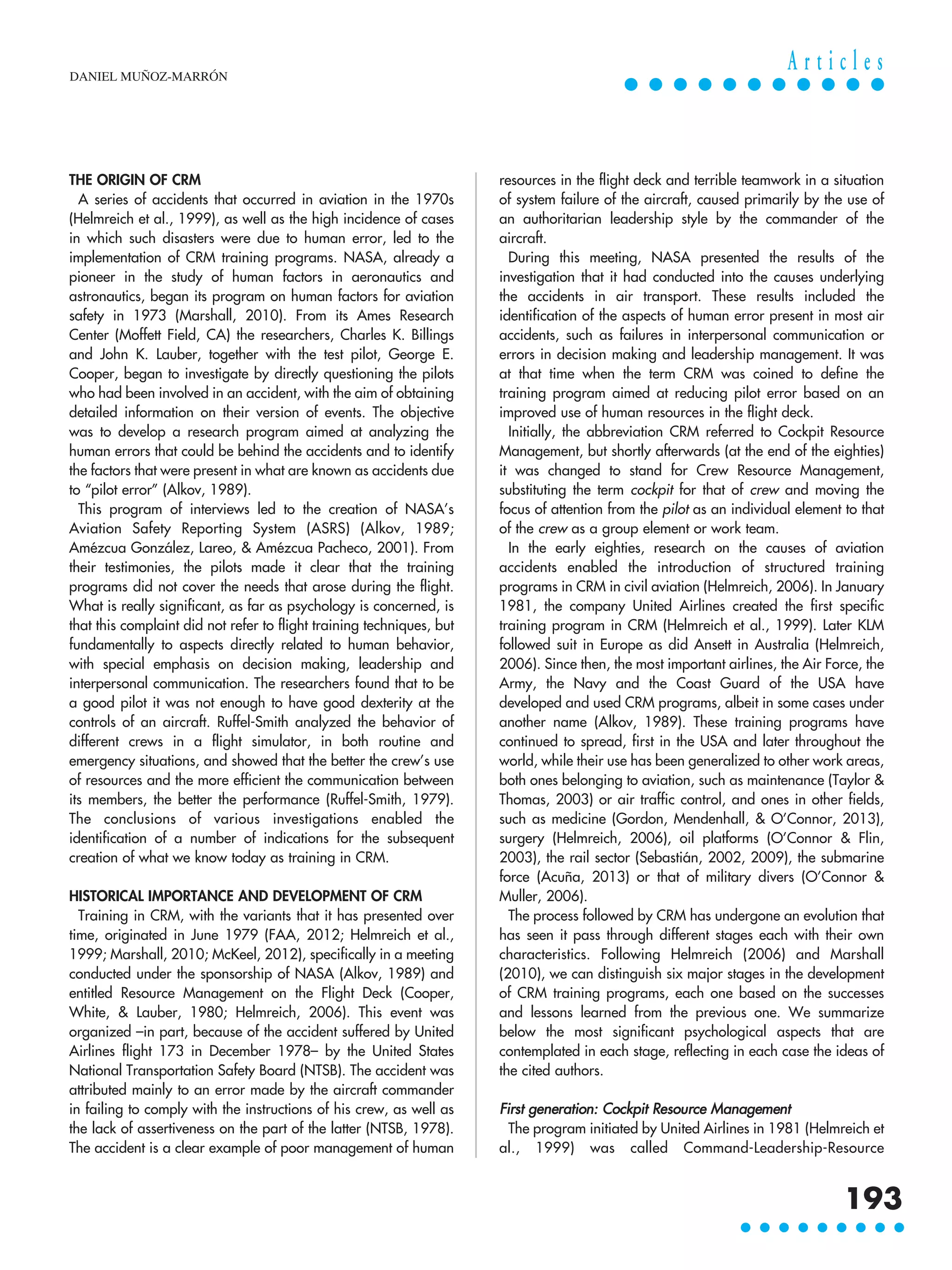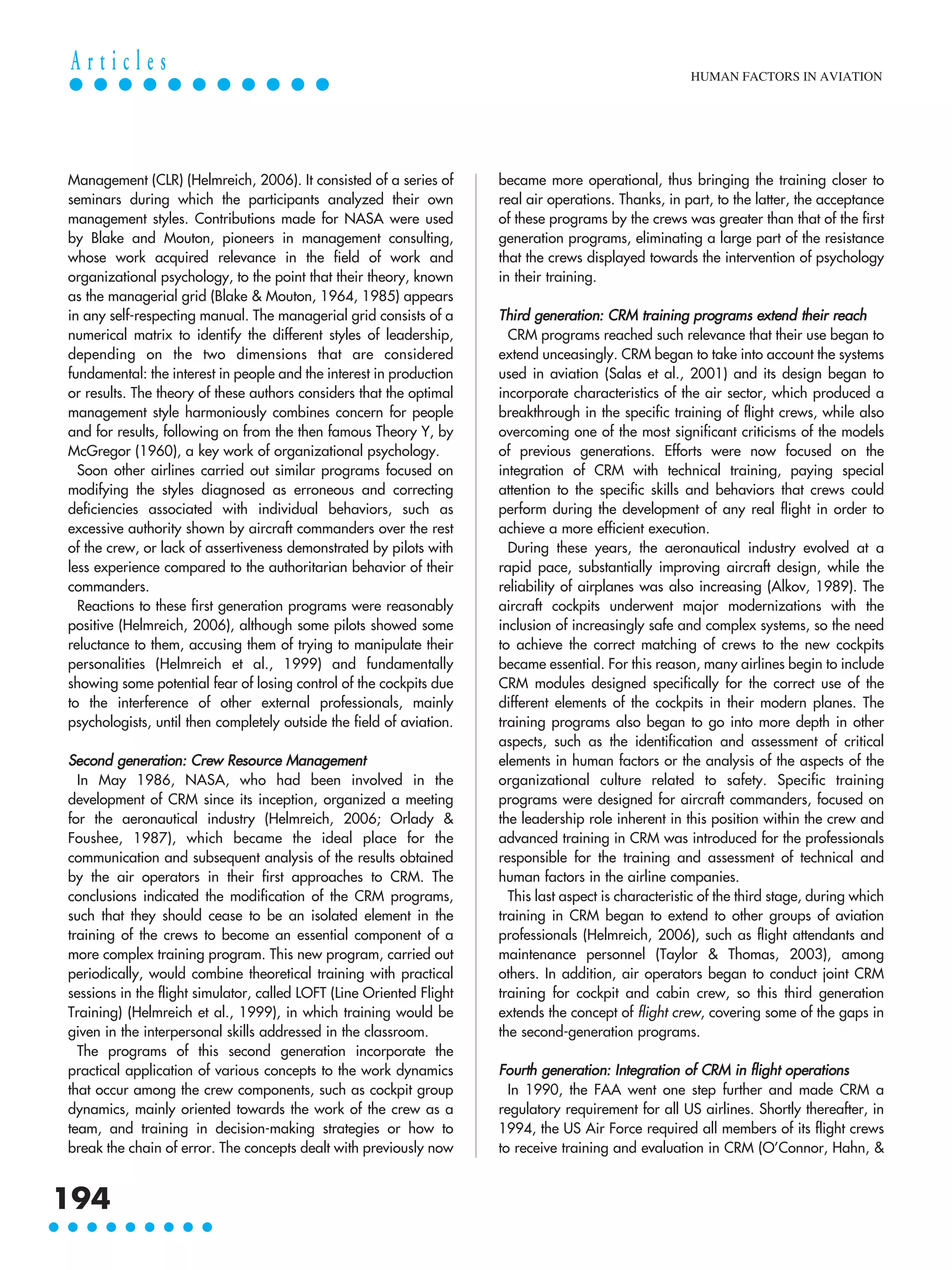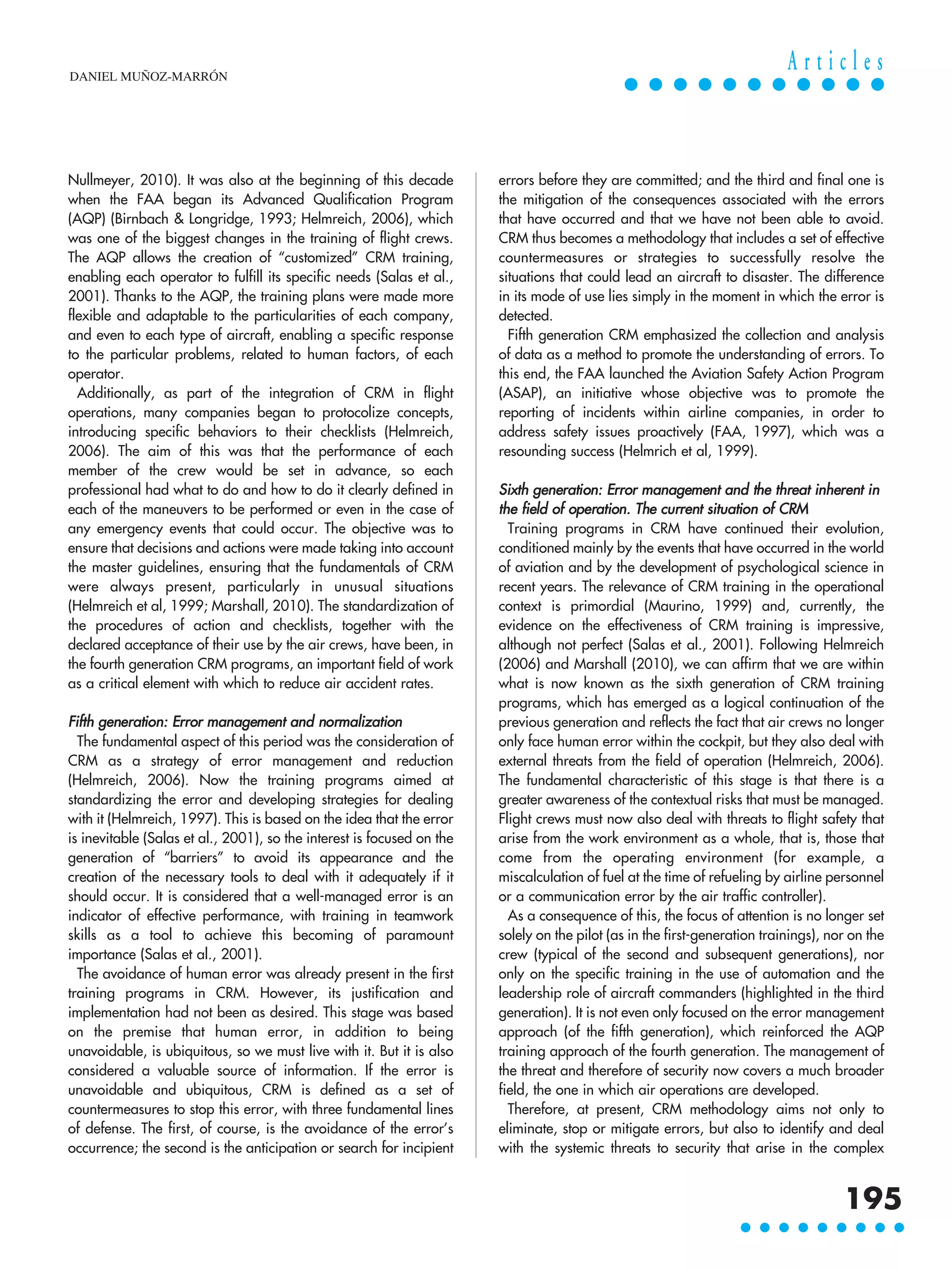The document discusses the history and development of Crew Resource Management (CRM) training programs in aviation. It describes how CRM originated from studies conducted by NASA in the 1970s that identified human factors like poor communication and decision making as contributing to aviation accidents. The first CRM program was established in 1979 and aimed to improve crew performance and reduce human error through training. CRM has since been adopted widely and has evolved over several generations to encompass additional topics like leadership, situation awareness, and personal limitations. It is now considered one of the major successes of applied psychology in optimizing flight safety.

![WHAT IS CRM?
Designed to reduce the mistakes and increase the effectiveness
of air crews (Wiener, Kanki, & Helmreich, 1993), CRM can be
defined as the optimal use, by an air crew, of all available
resources (information, material equipment and human
resources) for the achievement of safe and efficient flight
operations (Lauber, 1984). It encompasses a set of behaviors
and strategies that the flight crew possesses and has to follow
(Helmreich & Foushee, 1993), for the sake of safety, and
constitutes the formal recognition by the aeronautical sector of
the importance of the study of human factors in the optimization
of air operations and flight safety.
Used in both commercial and military aviation, CRM is actually
a global program of preparation and training in management
skills and abilities, evidence-based, and designed to improve
communication, decision making and adaptation among team
members in critical situations (Salas, Burke, Bowers, & Wilson,
2001; Shuffler, DiazGranados, & Salas, 2011); a tool to
combat accidents in which deficient teamwork in the cockpit
could be a precipitating factor (Salas, Wilson, & Edens, 2009).
The objective of the program is to combine technical and human
skills in order to achieve safer and more efficient air operations
(Federal Aviation Administration [FAA], 2012).
It is a method created to optimize performance by reducing the
effect of human error through the use of all resources to solve
problems, including people, technology and processes
(Marshall, 2010). In a more detailed way, Marshall himself
(2010) based his definition of the program on three
fundamental pillars that we summarize below:
4 A systems approach to security, which emphasizes the inher-
ent nature of error, promoting a non-punitive culture and fo-
cusing on specific and standardized work procedures.
4 A comprehensive system based on practice and operationally
aimed at the proactive application of human factors in order
to improve team performance.
4 A system characterized by: (1) defining the crew as a whole,
rather than the individual, as a standard training unit; (2) fo-
cusing on how the attitudes of crew members and their be-
haviors affect safety; (3) employing a methodology of active
and practical training, based on participation and mutual
learning; (4) including leadership techniques, work skills and
team management; (5) promoting the creation of participato-
ry work teams, preserving authority and the chain of com-
mand; and, (6) providing individuals and teams the
opportunity to review and analyze their own performance
and introduce the appropriate improvements.
CRM programs emphasize the nature of error in that they
recognize that to err is inherent in human behavior. In order to
reduce errors as much as possible, clearly defined work
procedures are created, while crews are provided with methods
to freely report the errors committed, without these being
accompanied by a sanction. These communications help to
develop a proactive performance improvement system, in that
the aim is to create “barriers to error” before they occur. Taking
the team as a unit of action, and through the use of a practical
methodology, based on active participation and mutual
learning, the program seeks to modify attitudes and establish
real work teams in which, without damaging the chain of
command, the participants can analyze their own performance
and introduce the relevant improvements in order to optimize
performance and achieve safer flight operations.
Training programs in CRM are, in short, a fundamental tool
created to improve the performance of a team with the aim of
reducing the effect of what is known as “human error” and
optimizing execution through the use of all available resources.
The appearance of CRM was a key milestone in the
psychology-aviation relationship and it brought about a radical
change in the study of aviation security, thanks to which
psychological science has become an essential pillar in the
search for flight safety and an ally of the aviation industry in the
development of training programs aimed at reducing human
error and increasing the effectiveness of flight crews.
For this reason, CRM is one of the success stories of modern
psychology and cognitive engineering (Cooke & Durso, 2007)
and an essential prevention tool in the current world of aviation
(Maurino, 1999), created within the world of psychology. CRM
strategies are currently used with the aim of improving safety,
reducing human error and providing crews with the necessary
training to enable them to make use of all of the resources at
their disposal (Salas & Cannon-Bowers, 2001).
Currently, CRM programs include different modules that
address key concepts based on a design that includes three
major areas of work: Command (direction, communication
processes and decision making), leadership (management, work
climate and team organization) and resource management
(management of resources, workload and situation analysis).
Introductory CRM courses, which are carried out by the
different airlines and the air force units of the Armed
Forces, generally last between two and five days, and are
run by psychologists and pilots who work together in their
development. Teaching methods include lectures, practical
exercises, role playing, case studies and accident
recreation videos (O’Connor & Flin, 2003), among other
work techniques. Although there is no standardized
methodology for their development (Salas, Fowlkes, Scout,
Milanovich, & Prince, 1999), the courses usually address
topics such as teamwork, leadership, situational
awareness, decision making, communication and personal
limitations (Flin & Martin, 2001), although there is
significant variability in this respect, mainly due to the fact
that their design is adapted to the needs of the air operator
that carries them out.
HUMAN FACTORS IN AVIATION
192
A r t i c l e s](https://image.slidesharecdn.com/humanfactorsinaviation-220618094249-7862339b/75/Human-Factors-in-Aviation-pdf-2-2048.jpg)




![Lauber, Blake, Mouton or Helmreich himself and his team of
collaborators at the University of Texas, caused the creation of
a branch of applied psychology with great future potential:
aeronautical psychology or aviation psychology.
Given that the objective of CRM has been well identified and
that the process is going in the desired direction in order to
achieve a higher level of aviation security based on a decrease
in human error, it is to be expected that psychology will continue
to have the importance it has had until now. We could even
suppose, without the slightest hint of exaggeration, that in future
research the contribution of psychology will be even greater,
with a special impact on the improvement of the training of all
airline personnel (an aspect that began in the fourth generation,
as it included the entire crew in the training programs), and the
selection, preparation and training of crews in areas such as
flexibility and creativity, given the key importance of these
qualities when implementing effective behavior in emergency
situations and the evidence of the gap that is found in the current
training on these matters (Muñoz-Marrón, in progress).
CONFLICT OF INTERESTS
There is no conflict of interest.
REFERENCES
Acuña, C. (2013). El entrenamiento CRM (Crew Resource
Management) aplicado al ámbito de la Fuerza de
Submarinos de la Armada Argentina (Operaciones de
Submarinos y de Buzos Tácticos) [CRM (Crew Resource
Management) training applied to the field of the Submarine
Force of the Argentine Navy (Operations of Submarines and
Tactical Divers)] (University Master’s thesis). Universidad
Nacional del Mar del Plata, Mar del Plata, Argentina.
Alkov, R. A. (1989). The Naval Safety Center’s aircrew
coordination training program. In E. Salas, K. A. Wilson & E.
Edens (Eds.), Critical essays on human factors in aviation:
Crew Resource Management (pp. 3-7). Hampshire, UK:
Ashgate.
Alonso, M. M. (1997). Psicología aeronáutica: Desarrollos
actuales [Aeronautical psychology: Current developments].
In 9º Congreso Argentino de Psicología [9th Argentine
Congress of Psychology], Tucumán, Argentina.
Amézcua González, L., Lareo, J. & Amézcua Pacheco, O.
(2001). Medicina aeronáutica [Aeronautical medicine].
Madrid, Spain: Fundación de Estudios y Formación Sanitaria
[Health Studies and Training Foundation].
Baumgarten, F. (1957). Examen de las aptitudes profesionales
[Examination of professional skills]. Barcelona, Spain: Labor.
Birnbach, R. & Longridge, T. (1993). The regulatory perspective.
In E. Wiener, B. Kanki, & R. Helmreich (Eds.), Cockpit
Resource Management (pp. 263-282). San Diego, CA:
Academic Press.
Blake, R. & Mouton, J. (1964). The Managerial Grid: The key to
leadership excellence. Houston, TX: Gulf Publishing Co.
Blake, R. & Mouton, J. (1985). The Managerial Grid III: The key
to leadership Excellence. Houston, TX: Gulf Publishing Co.
Cooke, N. & Durso, F. (2007). Stories of modern technology.
Failures and cognitive engineering successes. Boca Raton, FL:
CRC Press.
Cooper, G. E., White, M. D. & Lauber, J. K. (Eds.) (1980).
Resource Management on the flightdeck: Proceedings of a
NASA Industry Workshop (NASA CP-2120). Moffett Field,
CA: NASA-Ames Research Center.
Degani, A., Heymann, M. & Shafto, M. (1999). Formal aspects
of procedures: The problem of sequential correctness.
Proceedings of the Human Factors and Ergonomics Society
Annual Meeting, 43(20), 1113-1117.
https://doi.org/10.1177/154193129904302012
Dockeray, F. & Isaacs, S. (1921). Psychological research in
aviation in Italy, France, England, and the American
Expeditionary Forces. Journal of Comparative Psychology, 1,
115-148.
Federal Aviation Administration (1997). Aviation safety action
programs. Advisory Circular 120-66. Washington, DC:
Autor.
Federal Aviation Administration (2012). The History of CRM
[Video]. Washington, DC: F.A.A. TV.
Flin, R. & Martin, L. (2001). Behavioural markers for CRM: A
review of current practice. International Journal of Aviation
Psychology, 11, 95-118.
Gordon, S., Mendenhall, P. & O´Connor, B. B. (2013). Beyond
the checklist: What else health care can learn from aviation
teamwork and safety. New York, NY: Cornell University
Press.
Helmreich, R. L. (1997). Managing human error in aviation.
Scientific American, 276(5), 62-67.
Helmreich, R. L. (1999). Building safety on the three cultures of
aviation. Proceedings of the IATA Human Factors Seminar
(pp. 39- 43). Bangkok, Thailand, August 12, 1998.
Helmreich, R. L. (2006). Red alert. Flight Safety Australia,
September-October, 24-31.
Helmreich, R. L. & Foushee, H. C. (1993). Why Crew Resource
Management? Empirical and theoretical bases of human
factors training in aviation. In E. Wiener, B. Kanki & R.
Helmreich (Eds.), Cockpit Resource Management (pp. 3-45).
San Diego, CA: Academic Press.
Helmreich, R. L., Merritt, A. C. & Wilhelm, J. A. (1999). The
evolution of Crew Resource Management training in
commercial aviation. International Journal of Aviation
Psychology, 9(1), 19-32.
International Civil Aviation Organization (1989). Human
Factors Digest Nº2: Flight crew training: Cockpit Resource
Management (CRM) and Line-Oriented Flight Training (LOFT)
DANIEL MUÑOZ-MARRÓN
197
A r t i c l e s](https://image.slidesharecdn.com/humanfactorsinaviation-220618094249-7862339b/75/Human-Factors-in-Aviation-pdf-7-2048.jpg)
![(Circular 217-AN/132). Montreal, Canada: Autor.
International Civil Aviation Organization (1998). Human factors
training manual (Doc. 9683-AN/950). Montreal, Canada:
Autor.
Lauber, J. K. (1984). Resource management in the cockpit. Air
Line Pilot, 53, 20-30.
Lewin, K. (1940). Studies in topological and vector psychology:
1. Formalization and progress in psychology. University of
Iowa Studies in Child Welfare 16(3), 9-42.
Lewin, K. (1945). Reserve program of group dynamics. The
Research Center for Group Dynamics at Massachusetts
Institute of Technology. Sociometry, VIII(2), 126-136.
Lewin, K. (1947). Frontiers in group dynamics: Concept, method
and reality in social science; social equilibria and social
change. Human Relations, 1(1), 5-41.
Lewin, K., Lippitt, R. & White, K. (1939). Patterns of aggressive
behavior in experimentally created social climates. Journal of
Social Psychology, 10, 271-299.
Maier, N. R. F., Solem, A. R. & Maier, A. A. (1975). The role-
play technique. A handbook for management and leadership
practice. California: University Associates.
Marshall, D. (2010). Crew Resource Management: From patient
safety to high reliability. Denver, CO: Safer Healthcare
Partners.
Maurino, D. E. (1999). Crew Resource Management: A time for
reflection. In D. J. Garland, J. A. Wise & V. D. Hopkin (Eds.),
Handbook of aviation human factors (pp. 215-234),
Mahwah, NJ: Lawrence Erlbaum Associates.
McGregor, D. (1960). The human side of enterprise. New York,
NY: McGraw-Hill.
McKeel, G. (2012). Crew Resource Management. What’s Next
to SADCLAM? Marine Corps Gazette, 96(5), 44-46.
Muñoz-Marrón, D. (in progress). La Creatividad como
componente de la Gestión de Recursos de la Tripulación
(CRM) y su influencia en la prevención de los Accidentes
Aéreos [Creativity as a component of Crew Resource
Management (CRM) and its influence in the prevention of Air
Accidents] (PhD thesis). Universidad Complutense de
Madrid, Madrid, Spain.
Muñoz-Marrón, D., Gil, F. & Lanero, A. (in progress). Are crews
empowered with all the resources needed to successfully
address an inflight emergency? Checklist: A necessary but
insufficient tool.
National Transportation Safety Board (1978). Aircraft accident
report: United Airlines, Inc. McDonnell-Douglas DC-8-81,
N8082U Portland, Oregon. December 28, 1978.
Washington, DC: United States Government.
O´Connor, P. & Flin, R. (2003). Crew Resource Management
training for offshore oil production teams. Safety Science, 41,
591-609.
O’Connor, P., Hahn, R. G. & Nullmeyer, R., (2010). The
military perspective. In Kanki, B. G., Helmreich, R. L. & Anca,
J. (Eds.), Crew Resource Management (pp. 445-466). San
Diego, CA: Academic Press.
O’Connor, P., Jones, D., McCauley, M. & Buttrey, S. E. (2012).
An evaluation of the effectiveness of the crew resource
management program in naval aviation. International
Journal of Human Factors and Ergonomics, 1(1), 21-40.
O’Connor, P., Muller, M. (2006). A novel human factors
training curriculum for U.S. Navy diving. Paper presented at
the Undersea and Hyperbaric Medical Society Meeting,
Orlando, FL.
Orlady, H. W. & Foushee, H. C. (1987). Cockpit resource
management training (Technical Report NASA CP- 2455).
Moffett Field, CA: NASA-Ames Research Center.
Ranter, H. (2016). Aviation safety network. Alexandria, VA:
Flight Safety Foundation. Retrieved from https://aviation-
safety.net
Ruffell Smith, H. P. (1979). A simulator study of the interaction
of pilot workload with errors, vigilance, and decisions
(NASA TM-78483). Moffett Field, CA: NASA-Ames
Research Center.
Sáiz, M. & Sáiz, D. (2012). El inicio de la psicología aplicada
a la aviación: Desde el principio del siglo XX a la década de
los años treinta [The beginning of psychology applied to
aviation: From the beginning of the 20th century to the
decade of the 1930s]. Revista de Historia de la Psicología,
33(4), 7-36.
Salas, E., Burke, C., Bowers, C. A. & Wilson, K. A. (2001).
Team training in the skies: Does Crew Resource Management
(CRM) training work? Human Factors, 43, 671-674.
Salas, E. & Cannon-Bowers, J. A. (2001). The science of
training: A decade of progress. Annual Reviews of
Psychology, 52, 471-499. doi:
10.1146/annurev.psych.52.1.471
Salas, E., Fowlkes, J. E., Scout, R. J., Milanovich, D. M. &
Prince, C. (1999). Does CRM training improve teamwork
skills in the cockpit? Two evaluation studies. Human Factors,
41(2), 326-343.
Salas, E., Wilson, K. A. & Edens, E. (Eds.) (2009). Critical
essays on human factors in aviation: Crew Resource
Management. Hampshire, UK: Ashgate.
Sebastián, M. L. (2002). Fallo humano: Evitando el error
[Human error: avoiding mistakes]. Líneas del Tren, 278, 22-
23.
Sebastián, M. L. (2009). Fallo humano: La quiebra de un
paradigma [Human error: The collapse of a paradigm].
Apuntes de Psicología, 27(1), 21-51.
Shuffler, M. L., DiazGranados, D. & Salas, E. (2011). There’s a
science for that: Team development interventions in
HUMAN FACTORS IN AVIATION
198
A r t i c l e s](https://image.slidesharecdn.com/humanfactorsinaviation-220618094249-7862339b/75/Human-Factors-in-Aviation-pdf-8-2048.jpg)
